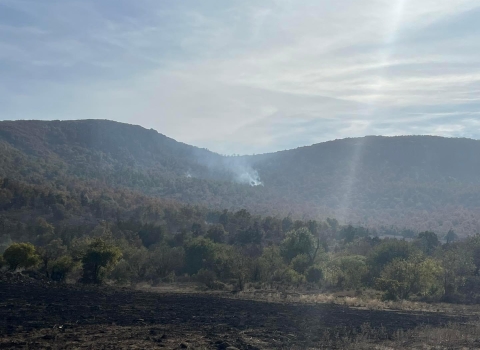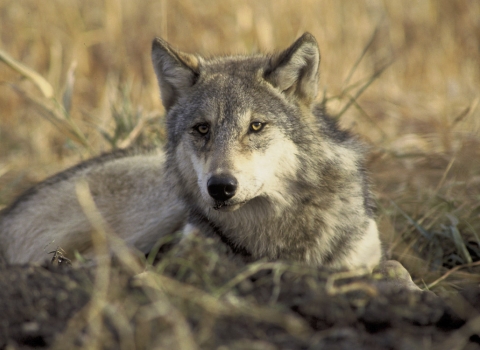The U.S. Fish and Wildlife Service, U.S. Geological Survey, and the University of Wisconsin–Madison, today announced receipt of a more than $2.5 million grant to develop an innovative treatment to prevent white-nose syndrome, a fungal disease decimating North American bat populations. The award is one of six provided by the Partnership to Advance Conservation Science and Practice, an $8-million collaboration between the National Science Foundation and the Paul G. Allen Family Foundation to fund scientific research and conservation activities that protect diverse ecosystems and imperiled species across the country.
The project, led by Bruce Klein, professor of pediatrics, medicine and medical microbiology and immunology at UW–Madison, will investigate a vaccine and FDA-approved receptor inhibitors that could potentially protect North American bats against the disease.
The research will be carried out primarily by the UW–Madison in collaboration with the USGS, the Service and partnering state wildlife agencies. Building on previous research, the project includes completion of laboratory testing followed by two years of field research coordinated by USGS and the Service in multiple states where imperiled bat populations are susceptible to the disease.
“We have high hopes that this research will prove to be a powerful tool for fighting white-nose syndrome in bat populations that are most affected,” said Jonathan Reichard, assistant national white-nose syndrome coordinator for the Service. “This award will advance collaborations to address critical information gaps and develop effective management tools for this devastating wildlife disease.”
White-nose syndrome affects hibernating bats and is caused by an invasive, cold-loving fungus. The fungus grows on and into bats’ skin, disturbing their hibernation and leading to dehydration, starvation and often death. First documented in New York in 2006, white-nose syndrome has since spread to 38 states and eight Canadian provinces and has been confirmed in 12 North American bat species.
“Bats are vital to our planet’s ecosystem and biodiversity, and we are pleased that our research discoveries might drive development of a tool to advance the conservation of numerous bat species,” said Klein. “We’re also excited about the collaborative potential for this work to support the USGS, the U.S. Fish and Wildlife Service and state agencies in their efforts to protect bats against the devastating impact of white-nose syndrome.”
The project seeks to develop an immune-based strategy to prevent disease by using a model system, developed by UW–Madison researchers, to investigate early interactions between bat skin and the fungus. Researchers will test how receptors in the skin may also influence susceptibility to white-nose syndrome, and how application of FDA-approved drugs alone or in combination with vaccination can protect bats against white-nose syndrome.
Tonie Rocke, research epidemiologist for the U.S. Geological Survey, collaborated with Klein and others at UW–Madison to create the vaccine for use against white-nose syndrome. Initial field research has shown some promise in reducing fungal loads and curtailing the impact of the disease in hibernating bats.
“Using FDA-approved drugs alongside our white-nose vaccine could enhance the response we saw in our vaccine trials, providing an additional tool for managing the disease in threatened bat populations,” said Rocke.
Widespread throughout the U.S. and Canada, white-nose syndrome has led to declines of over 90% of northern long-eared, little brown and tri-colored bat populations in less than 10 years. Due to this high mortality rate, the northern long-eared bat was reclassified from threatened to endangered status under the Endangered Species Act in March, and the tricolored bat was proposed for endangered status in September 2022.
Communities and countries all over the world are dealing with a crisis of extinction. With climate change climate change
Climate change includes both global warming driven by human-induced emissions of greenhouse gases and the resulting large-scale shifts in weather patterns. Though there have been previous periods of climatic change, since the mid-20th century humans have had an unprecedented impact on Earth's climate system and caused change on a global scale.
Learn more about climate change and habitat loss pushing more and more species to the brink, now is the time to be proactive, collaborative, and innovative in our efforts to save America's wildlife and plant species. Today’s announcement comes as the ESA turns 50 years old in 2023. Throughout the year, the Department of the Interior will celebrate the ESA's importance in preventing imperiled species' extinction, promoting the recovery of wildlife, and conserving the habitats upon which they depend.
The Service leads the national response to white-nose syndrome through a collaborative effort that includes coordination among state, federal, Tribal and non-governmental partners. The agency also offers grants to institutions and natural resource management agencies to advance disease research and identify new solutions to meet a variety of conservation challenges for hibernating bats.
Scientists worldwide are working together to study white-nose syndrome and determine how it can be controlled. Bats eat huge amounts of insects, including harmful agricultural and forest pests. In the United States alone, bats are estimated to save farmers at least $3.7 billion per year in pest control services. The loss of millions of bats to white-nose syndrome can have cascading effects on the environment, with potential to affect forest, agricultural and human health.
Additional information can be found here:
National white-nose syndrome website: www.whitenosesyndrome.org/
Information about how USGS is addressing WNS: https://www.usgs.gov/centers/nwhc/science/white-nose-syndrome
The NSF announcement can be found at https://www.nsf.gov/news/news_summ.jsp?=y&cntn_id=306871&org=BIO



